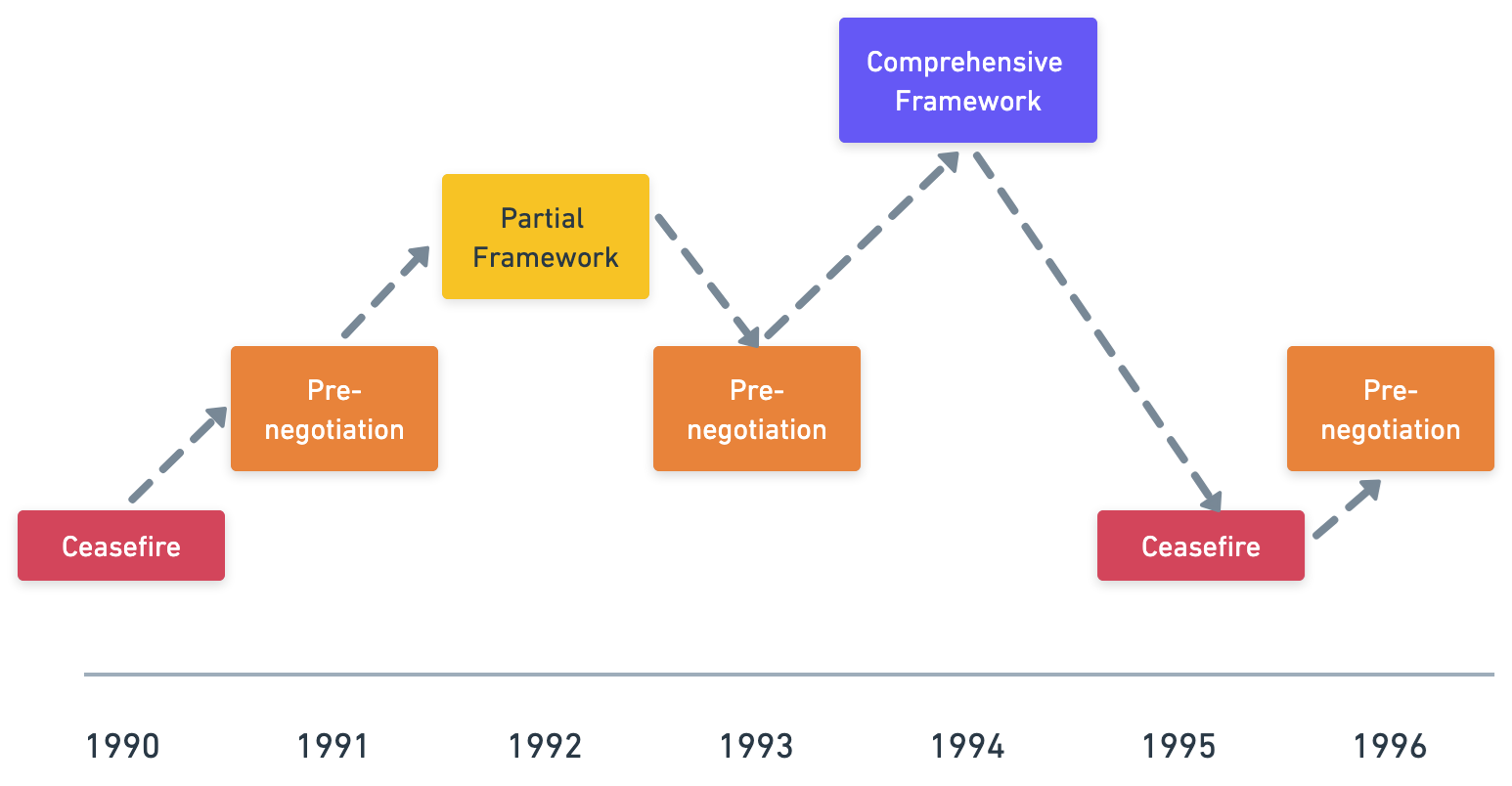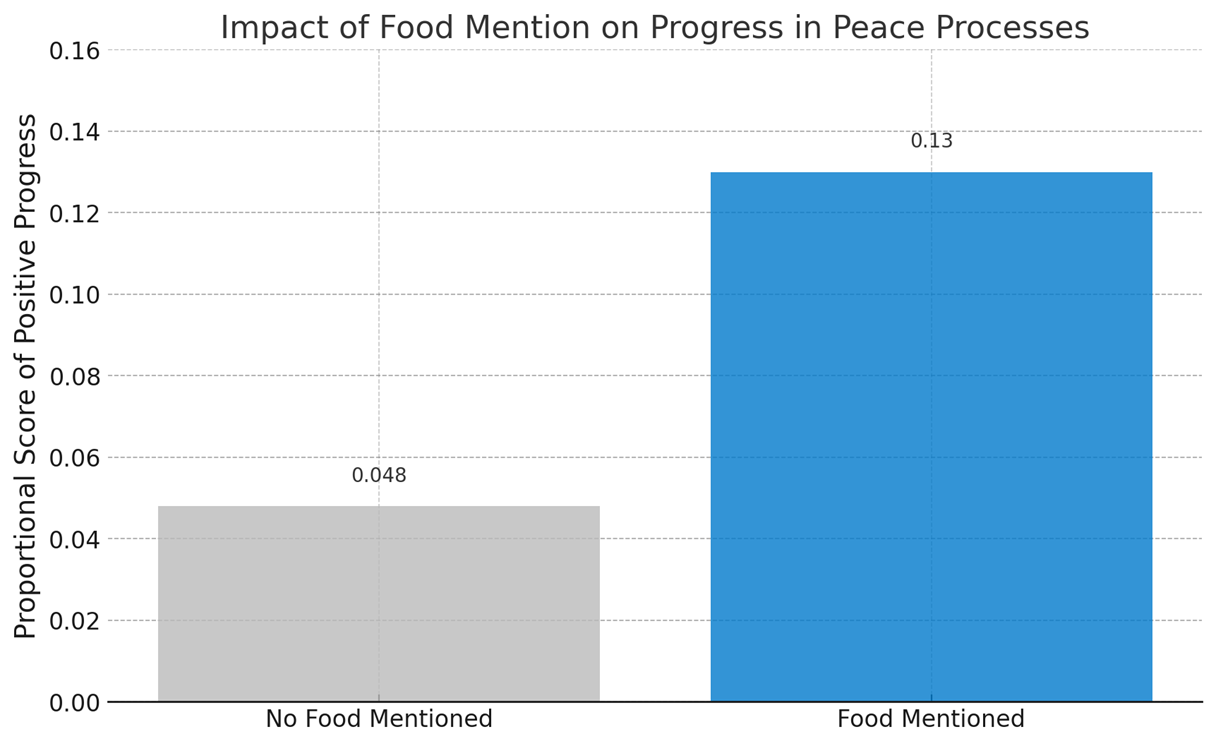How Including Food May Strengthen Peacebuilding Efforts
Authors: Seán Gurrin and Joanna Pedrina
Date: 10 May 2024
With rising global food crises being linked to escalating conflicts, exploring how food is addressed in peace processes could give us valuable insights into the complex relationship between food and conflict. As part of UCD’s Connected_Politics Lab, we set out to study the connection between mentions of food topics within peace agreements and the outcome of related peace processes.
Why Food Matters in Conflict Resolution
A recent downturn in global food security mainly caused by conflicts, economic shocks, and climate-related disasters (highlighted in the 2024 Global Report on Food Crises), suggests that there is urgency to understand how food security relates to conflict resolution and prevention.
Food security is not solely about providing for immediate basic needs but is deeply intertwined with socio-economic stability and sustainable development. By including food security as an important part of the peacebuilding process, tending more holistically to fundamental human necessities, it may also address underlying issues that often cause or exacerbate conflict.
Preventing conflict is just as important as resolving it. Addressing food security in conflict resolution may contribute to ending the cyclical relationship between conflict and hunger by reducing grievances that arise from resource shortages and competition. For example, including commitments and provisions to support sustainable farming, or addressing land issues and access to water in peace agreements may address potential triggers before they escalate into renewed violence.
Why Peace Agreements?
Assessing how food is addressed in conflict and conflict resolution is extremely difficult given the challenging nature of systematically collecting data in the context of conflict. Because of this, we relied on formal peace processes and the related peace agreements between conflicting parties to gather empirical data about how food security was potentially addressed during conflicts and the peace process.
Our project looks at the presence of food related topics in peace agreements by using the Peace Agreements Index (PA-X) database, developed by the University of Edinburgh. The PA-X database covers 171 peace processes and a total of 2003 individual peace agreements, 388 of which mentioned a food related topic at least once. The database covers global peace agreements from 1990 to 2023, providing a rich dataset for analysing trends and outcomes associated with conflict resolution and peace processes.
Where and how does food feature in peace agreements?
Because of lack of research in this area, we broadly looked at how food words and topics appear in peace agreements. One of the main questions we wanted to answer was: do mentions of food topics in a peace agreement have a positive effect on a transition towards a peaceful outcome? The vast majority of peace agreements fall into one of five sequential stages. As shown in figure 1 below, these five stages, in progressive order, indicate the progress in conflict resolution, going from a ceasefire to the final implementation of what was agreed upon in the peace agreements.
Figure 1: The Different Stages of Peace Processes

To investigate our research question, the text of each agreement was compiled and the text was cleaned and tokenized so that it could be then analysed using quantitative text analysis methods. We created a dictionary of all relevant food related words which contained 59 words related to food, with “food”, “agricultural”, “crops”, and “livestock” being the most commonly found words in the content of the agreements. Then we turned the presence of a food topic within each agreement into a binary variable: food included or food not included. To be able to answer our question, each agreement was first ordered by its respective peace process stage and then ordered chronologically so that we could assess the progress from one peace agreement to the next.
Figure 2: Illustration of how a peace process is often non-linear, moving up and down through the different stages

Figure 2 illustrates the complex progression of peace processes. The overall process is rarely linear and may have multiple phases going up and down through the different stages before reaching an agreement that can be implemented. To indicate the change from one peace agreement to the next we used three variables: +1 to indicate that there was a progression from one peace agreement to the next, -1 to indicate a regression in agreement stage, and 0 to indicate that there was no change in stage from one agreement to the next. We then added these numbers up to get an overall score of progression and compared the scores between agreements that mention food and agreements that exclude food. This allowed us to test whether the inclusion of food topics in a peace agreement is more likely to correspond to progression in the peace process stages.
Figure 3: Results: Higher Rate of Progress in Peace Process when Food is Mentioned

Results: The inclusion of food topics in peace agreements is more likely to correspond to progress in the peace process than when food is not included.
As can be seen in the graph above, when food is mentioned in a peace agreement, it is more likely to lead to progress in the peace process than in agreements that do not mention food. Although we should note that no change is the dominant effect observed from one agreement to the next, both when food is mentioned and when it is not. There are also far more agreements that don’t mention any food words than agreements that do. But when we tested the statistical strength of these results, the models indicated that agreements with food mentions are significantly more likely to correlate with progress in the peace process.
From this we can determine that including food topics in peace agreements corresponds to a significant likelihood of progress of a peace process. This suggests that including discussions around food and food security may have a positive effect on the peacebuilding processes.
The Broader Implications of this Study for Peacebuilding
The findings of this analysis suggest that there is a possibility that including food security topics has some positive effect on progression in peacebuilding efforts. Intuitively this makes sense: Not only does it address immediate human needs, but it also lays the groundwork for long-term stability and development, which are essential for preventing the resurgence of conflict.
Obviously, mentions of some food related words and topics in a peace agreement text cannot cause conflict de-escalation. Conflicts are extremely complicated and volatile in nature, making them notoriously challenging to study. But the suggestion of this study is that when food provisions, and other related holistic measures to address basic human needs, are brought into the fold of conflict resolution, there may be a positive effect on the outcome. Because of this, it is vital that we test these measures empirically when possible.
The Future of Studying Food in Peace Processes
Considering only a fraction of all documented agreements mention food security, there is scope for further research. Future studies could explore the different types and categories of food topics, such as agriculture and cultural food practices. Another potential avenue for future research could be to further investigate exactly how food is discussed in the peace agreement texts, i.e. there may be a difference in outcomes between mentioning food within a broader package of security measures compared to an agreement that discusses food security in a detailed and nuanced fashion. Finally, finding creative ways to empirically study food security and its connection to conflict will help deepen the research and assess the effectiveness of food-related measures in peace building.